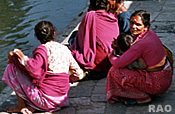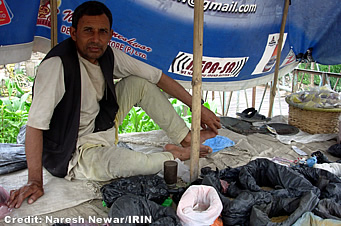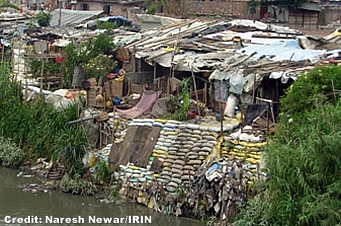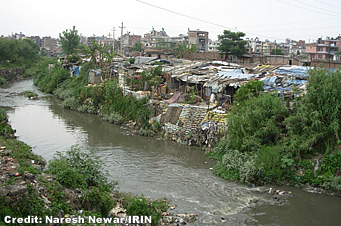 |
Nepal SOCIAL LIFE |
|
 |
Nepal Information |
|
|
 |
|
Impoverished
urban squatters face high risk of poor health
|
 |
 |
| Impoverished squatters in Kathmandu survive with minimum income
The
growing population of the Nepali capital, Kathmandu, has exacerbated the
plight of the city's estimated 50,000 squatters who are among the poorest
people in Nepal, according to a study by local non-governmental organisation
(NGO) Water Aid Nepal.People
living in squatter areas are the most vulnerable to preventable communicable
and non-communicable diseases and have high rates of mortality, said the
study, entitled 'Health and Hygiene Issues of Vulnerable Groups in Low
Income Urban Communities'. |
|
Rapid
rural-urban migration over the past decade has led to the overpopulation
of most city areas, exerting heavy pressure on the city's limited infrastructure
and services. According to the Nepalese government, the population of the
Kathmandu Valley tri-city area - including Lalitpur and Bhaktapur - has
more than doubled between 1994 and 2004. Today, it stands at some 1.5 million
people.
The
major problems faced by the city's poor are a limited supply of clean drinking
water, and poor sanitation, health and hygiene, according to local NGO
Lumanti.
In
addition, urbanisation has contributed to making the already contaminated
water of Bagmati River worse. The government has failed to manage a proper
sewerage system in the city, according to Lumanti. Squatters are the most
affected as they all live on land close to the river, the only available
space for them.
It
is a wretched life for 76-year-old Rohindra Bahadur Karki, a squatter in
the Jagriti Nagar area, an impoverished neighbourhood in the city centre.
Last year he lost both his 44-year-old son, Ram Krishna, and his daughter-in-law,
34-year-old Goma, simply because he was unable to afford medical treatment
for them.
''Just
take a look at how we live and you can judge why people, especially children
and the elderly, get sick all the time''
Their
health had been deteriorating over the years while living in the squatter
area close to Kathmandu's heavily contaminated River Bagmati.
"I
took them to the government hospital but I didn't have enough money to
buy regular medication and they died," Karki told IRIN.
"I
don't know how long I can survive. I don't even have enough strength to
work any more," he said, and expressed concern about the welfare of his
two grandchildren, who also often get sick due to poor hygiene in this
largest squatter area of Kathmandu. Nearly 3,000 slum dwellers live there.
|
Four
million squatters
|
 |
 |
| In
Nepal, there are about four million squatters, known locally as Sukumbasi,
living in cities and towns, including 50,000 in Kathmandu, according to
the Society for the Preservation of Shelters and Habitation in Nepal (SPOSH-Nepal),
which advocates the rights of landless squatters.
According
to SPOSH-Nepal, there are over 66 squatter settlements in Kathmandu and
most are in unhygienic and unsanitary areas. The Sukumbasis migrated from
their food-deficit villages decades ago after natural disasters, which
made them homeless and landless, thus impoverishing them further. |
|
The squatters
survive on less than US$1 a day, SPOSH-Nepal officials say.
"It
is very common among the Sukumbasis to die of poor health due to poor sanitation
and lack of clean water so we have stopped complaining," said local squatter
Padma Prasad, adding that people die in this squatter area every 10 to
15 days.
"Just
take a look at how we live and you can judge why people, especially children
and the elderly, get sick all the time," said another squatter, Simi Lama.
|
No
mains water
|
 |
 |
| Unhygienic conditions in squatter settlements cause health concerns
Unhygienic
conditions in squatter settlements cause health concerns
Lama
said there is no mains water and people have to walk for nearly an hour
to reach the nearest public tap where they then have to queue for as much
as five hours to get a bucket of clean drinking water. |
|
Now
that the monsoon is imminent, local squatters fear sickness from water-borne
diseases. Government hospitals are always crowded and squatters cannot
afford to pay for treatment and medicines despite the subsidised health
service.
|
Cooperatives
|
 |
"We
decided to take matters into our own hands and not wait for the government's
help," squatter Mankumari Ale told IRIN. She and her neighbours in Mandikatar
decided to form a committee and collect money each month from whatever
savings they had.
They
were able to establish a cooperative and, with the support of Lumanti NGO,
managed to collect enough funds to begin income generation activities,
and members also started to clean their area, build toilets and install
a drinking water tank.
"Over
the last five years we have managed to save many lives, and now not many
get sick," said Ale, adding that other squatter settlements should try
to form their own cooperatives and work together.
|
Women,
babies at risk
|
 |
Those
squatters most affected by poor hygiene and poverty are women, and many
still deliver babies at home in unsafe environments. Babies stand a high
risk of infection due to unsanitary conditions, according to the Nepal
Mahila Ekta Samaj, a squatter women's group helping to promote the rights
of female squatters.
"Urgent
attention and the immediate introduction of health services are needed
for the women. Failure to do this would put many lives of children and
mothers at risk," said Bina Bajracharya, a senior member of the group.
Source: IRIN 2007
Copyright
© UN Office for the Coordination of Humanitarian Affairs 2007
[
This report does not necessarily reflect the views of the United Nations]
Integrated
Regional Information Networks (IRIN), part of the UN Office for the Coordination
of Humanitarian Affairs (OCHA). |
 |
| more information |
 |
 |
 |
Externe
Links |
 |
|
Kathmandu
Valley
|
|







